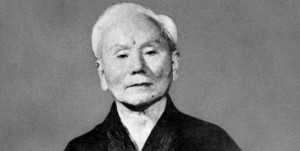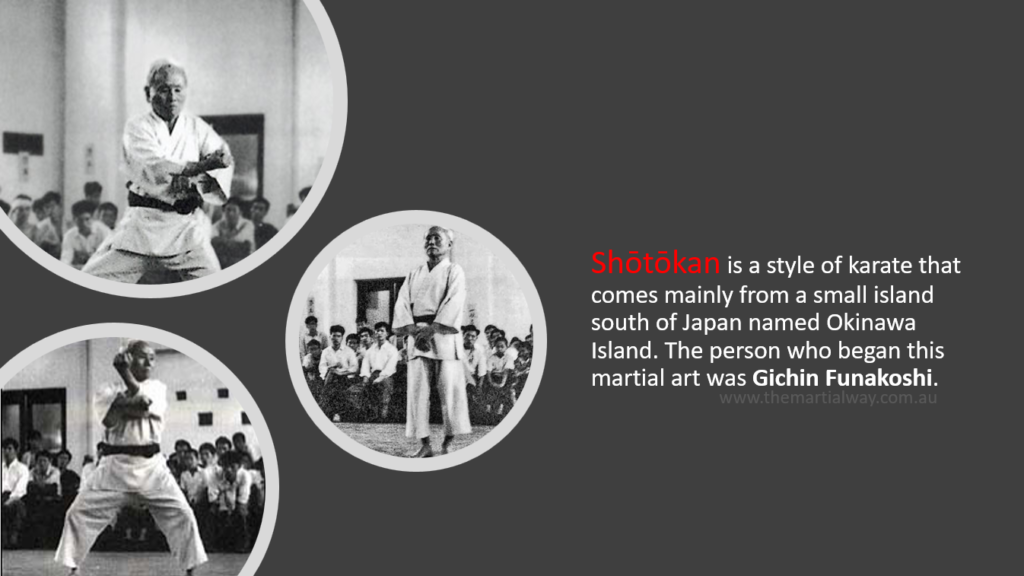Shōtōkan (松濤館 ) Karate (空手) is a traditional Japanese Martial Art founded by Master Gichin Funakoshi. Shōtōkan Karate remains firmly rooted in a strong martial arts tradition. It emphasises a lifetime of training for a healthier mind and body, rather than for sport.
Shōtōkan Karate is predominantly a weaponless martial art style that is founded on the basic physical techniques of punching, striking, kicking and blocking. The power from these techniques largely relies on the movement of the hips. As you progress higher up the ranks there becomes a deeper psychological component to serious Karate training which develops character.
Amongst other styles, Shōtōkan Karate is a way for an individual to realise greater potential and expand the limits of one's Physical and Psychological capabilities. Karate-Dō is a time-proven method of personal and mental development.
"Karate-Do strives internally to train the mind to develop a clear conscience, enabling one to face the world honestly, while externally developing strength to the point where one may overcome even ferocious wild animals. Mind and technique become one in true karate" - Master Gichin Funakoshi.
The word Karate is a combination of two Japanese characters: Kara 空, meaning empty, and te 手, meaning hand; thus, Karate 空手 means “empty hand.” Adding the suffix “-dō” 道 (pronounced “doe”), meaning “way,” i.e., Karate-dō 空手道, implies Karate as a total way of life that goes well beyond the self-defence applications. In traditional Karate-dō, we always keep in mind that the true opponent is oneself.
Shōtōkan Karate Lineage

Karate’s pre-history can be traced back to Daruma (aka Bodhidharma), founder of Zen Buddhism in Western India. Daruma is said to have introduced Buddhism into China somewhere around the year 500 CE, incorporating spiritual and physical teaching methods that were so demanding that many of his disciples would drop in exhaustion. In order to give them greater strength and endurance, he developed a more progressive training system. Daruma’s book, Ekkin-Kyo, can be considered the first book on martial arts, and his training and philosophy were adopted by the Shaolin Temple in northern China.
The modern history of Karate begins in Okinawa. Okinawa-te (Okinawan hand), or simply te, was a simple but highly effective method evolving through centuries of use in real combat. The banning of weapons on the island for two long periods in its history contributed to the high degree of development of this method. But Okinawa-te was also influenced by the much more elaborate techniques and philosophical teachings of Shaolin kung fu and China’s southern Shokei style. These origins explain the dual nature of karate: extremely violent and efficient but at the same time a strictly disciplined philosophy with a nonviolent emphasis.
The Influence of Master Funakoshi
The Influence of Master Funakoshi

Master Funakoshi Gichin
In 1916 Master Gichin Funakoshi became the first expert to introduce Karate-dō from Okinawa to mainland Japan. One of the few people to have been initiated into all the major Okinawan Karate methods, Master Funakoshi taught a synthesis of the Okinawan styles as a total discipline. This method became known as Shōtōkan (literally “House of Shōtō,” Funakoshi’s pen name as a poet). Because the style became very popular in Japan and proceeded to spread throughout the world, Funakoshi is widely considered to be the “father of modern karate-do.”
Learn More on Gichin Funakoshi
Benefits of Karate Practice
"True karate is this: that in daily life one’s mind and body be trained and developed in a spirit of humility, and that in critical times, one be devoted utterly to the cause of justice" - Master Gichin Funakoshi
Karate is a holistic practice that benefits the student in all areas of their life. Karate encourages proficiency in the physical form as well as the co-ordination of the mind and body. It is an art where advancing age can be beneficial, as life experience and maturity can further assist with mental discipline.
Karate practice:
- strengthens the mind, develops composure and a clearer thought process
- develops self-confidence and self-esteem
- strengthens the entire body, improves coordination, quickens reflexes, builds stamina and overall health
- teaches the values of courtesy, integrity, humility, justice, honor, and self-control
Master Gichin Funakoshi said that “mind and technique are to become one in true karate.” We endeavour to make our physical techniques reflect our mind’s intention. Through consistent Karate practice we are strengthening the connection between mind, body and spirit. For example, when we consciously try to identify and eliminate weak and indecisive movements in our Karate practice, it can help us to eliminate weakness and indecision in our minds—and vice versa.
Shōtōkan Tiger Symbol

When a student of Karate hears the term “Shōtōkan Tiger,” one image comes to mind: the traditional symbol of the tiger inside the circle which has become representative of Shōtōkan Karate.
That symbol is properly called the “Tora no Maki,” or the Tiger Scroll.
The drawing was originally created by a Japanese man named Hoan Kusugi who was a friend and student of Funakoshi. The character up in the northeast quadrant of the circle is part of the artist’s signature.
Kusugi was reportedly instrumental in convincing Funakoshi to teach Karate in Japan. He also was the man who first convinced Funakoshi to write his knowledge of Karate into a book, and promised him that if he would, he would design the book and make a drawing specifically to illustrate the book cover.
“Ryukyu Karate Kenpo,” Funakoshi’s first book about Karate, was written in 1922, but the plates for that original book were destroyed in the fire of the Great Kanto Earthquake in September of 1923. Later that year, Funkoshi released the book again, this time under the name of “Rentan Goshin Jutsu.”
Kusugi is reported to have declared to Funakoshi that his book was the master text of Karate. In Japanese, the master text for a particular topic is called the “Tora no Maki,” recalling the traditional practice of writing their documents as long scrolls. Already by Funokoshi’s time, the practice had been long abandoned, but the name stuck.
“Scroll of the Tiger” in this case is idiomatic and means “Key” or “Book of Knowledge.” The picture of the tiger in the circle is a pun on the words “Tora no Maki,” which could also be taken to mean “Roll of the Tiger.”
When Funakoshi created our system of martial arts, he chose the tiger as the animal symbol to represent Shōtōkan because it signified strength, power, and tenacity.
The tiger in the traditional circular image is a traditional Chinese design that implies “the tiger never sleeps.” It symbolises, therefore, the keen alertness of the wakeful tiger and serenity of the peaceful mind.
The Shōtōkan Tiger is drawn within a circle to show that the power of the tiger, like the power of Shōtōkan, is contained. It indicates that this power should never be used on a whim. The power is only unleashed, or broken from the circle, in order to defend ourselves or others who can’t defend themselves from a violent attack.
